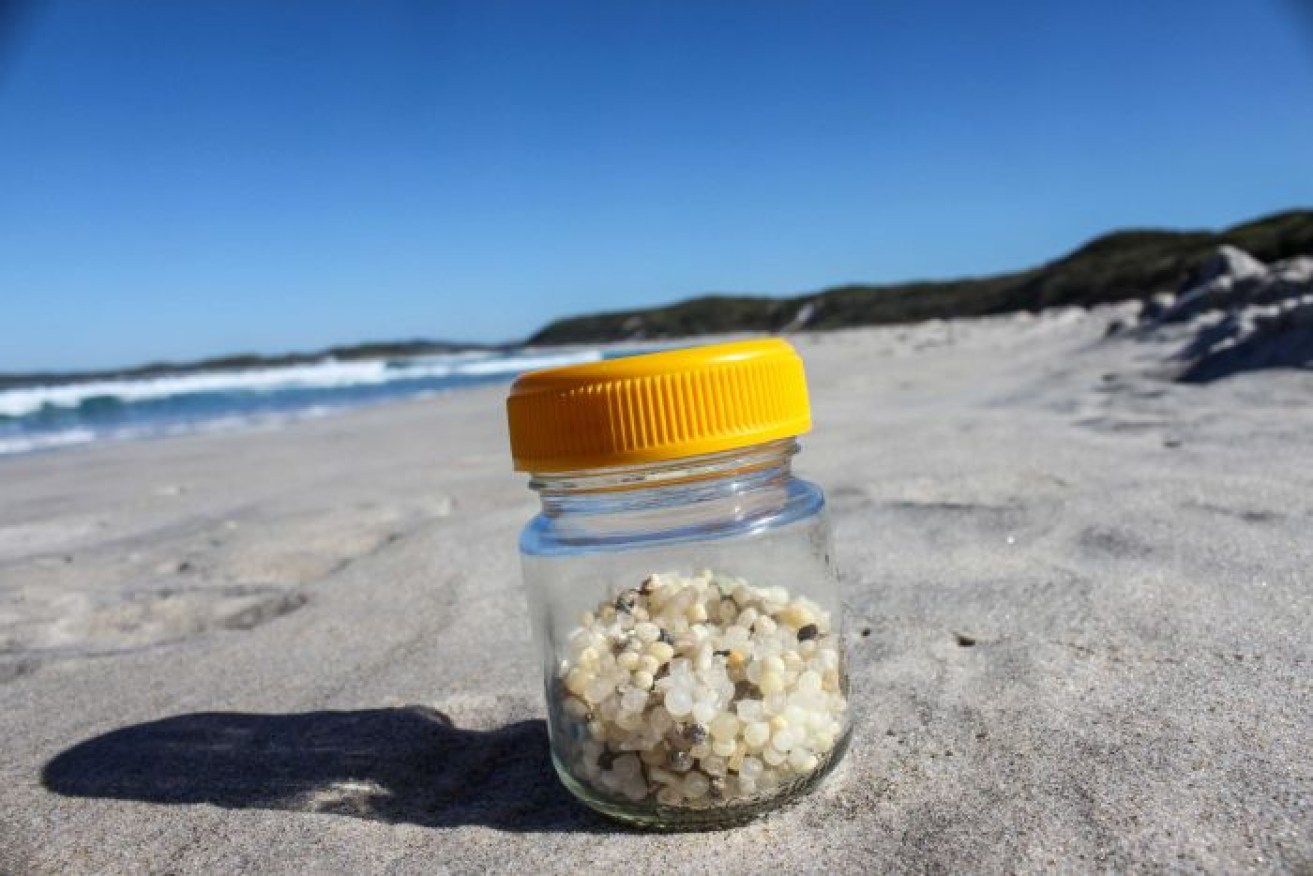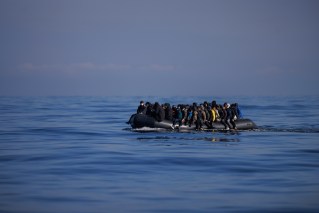Most plastic on our beaches could have come from anywhere. But not the Durban nurdle

These lentil-sized plastic pellets litter beaches all around Australia, particularly south-west WA. Photo: ABC RN: Fiona Pepper
In 2017, approximately 2.25 billion nurdles – tiny plastic pellets the size of a lentil – spilled from a ship moored in Durban in South Africa.
Now, just as predicted, they’re washing up on beaches in the south-west of Western Australia.
While nurdles might sound cute, they are anything but.
These pellets are the raw form of plastic, used since the 1960s as the basis of most plastic goods ranging from laptops through to milk bottles.
They can spill at the point of manufacture or while in transit, and when they do, they are extremely difficult to clean up.
That’s if anyone is prepared to take responsibility for the clean-up.

Dr Paterson and her friend Maxine look for nurdles on Mutton Bird Island beach in WA. Photo: ABC RN: Fiona Pepper
Thousands of kilometres from Durban, Harriet Paterson spends her days on hands and knees, methodically scouring local beaches for this plastic waste.
Dr Paterson, a biological oceanographer based in Albany, south of Perth, says around a third of the plastic she collects is made up of nurdles, from countless spills.
As far as most nurdles are concerned, their origins are mysterious – they could have been circulating the planet for the last 60 years.
But, Dr Paterson says, the Durban nurdles are different.
“We know what they look like, we know what their chemical signature is and we know where they started from,” she says.
This makes them particularly interesting to oceanographers tracking how currents carry rubbish around the ocean. And they provide a case study into the question of who should clean them up.
Where did the Durban nurdles come from?
The Durban nurdles’ ocean journey began on October 10, 2017, when the South African city was hit by a damaging storm, and five ships in the harbour, including the MSC Susanna, broke their moorings.
The MSC Susanna lost two containers overboard, dispersing more than 40 tonnes of nurdles that coated the harbour’s surface with “a white sheen”.
Lisa Guastella, a Durban-based oceanographer and meteorologist, remembers the “absolute panic” that followed the storm.
She says it was a few days before the nurdles began moving out of the harbour and then “started getting noticed a few days later, up and down the coast”.

Two 12-metre containers of nurdles fell off MSC Susanna during the 2017 storm in Durban. Photo: ABC RN: Salt Fishing South Africa
Within days of the storm, volunteers organised local clean-up efforts, and the owner of the cargo of nurdles employed a salvaging company to help.
Ms Guastella says it’s estimated that roughly a third of those spilt nurdles were cleaned up.
But that still left more that a billion nurdles floating in the ocean.
Since then, Ms Guastella has taken an interest in their trajectory.
“Initially it might be a local problem … but potentially, because these little things can float away on the ocean’s currents, it actually becomes a global problem,” she says.
Drifter trackers provided some indication as to where the Durban nurdles could wash up. Photo: ABC RN: Lisa Guastella
“Whatever wasn’t deposited on our beaches then got recirculated and then some got entrained into the main Aghulas Current.”
The Aghulas Current flows southward along the South African coast, before heading eastward to the flow from Africa to Australia.
By analysing drifter buoys, Ms Guastella predicted it would take roughly 500 days for the first nurdles to wash up on Australia’s south-west coast.
She contacted Dr Paterson. “It was basically to say, well, should these nurdles pitch up in Australia, if you do get numbers, it would be of scientific interest,” Ms Guastella says.
An ‘insidious’ form of plastic pollution
Now, 20 months since the spill, Dr Paterson has the painstaking task of monitoring south-west beaches for Durban nurdles.
Unlike an oil spill, where the pollution is immediately obvious, she says the damage nurdles cause is slower and a lot less obvious.
“It’s a little more insidious. The nurdles are going to be there for a long time, having a long-term effect,” Dr Paterson says.

Marine park ranger Peter Moore uses a dustpan and brush and colander to find nurdles. Photo: ABC RN: Fiona Pepper
Dr Paterson says most visitors to the beach simply can’t see them.
“Nurdles are cryptic, you really have to go looking for them,” she says.
“If you come to the beach, you’ll think it’s pristine. It’s not until you start looking a lot closer that you start to see just how much plastic there is.”
A major problem is that birds and fish often confuse nurdles for food.
“Nurdles mimic fish food – they look like fish eyes or fish eggs – so they’re actually quite attractive for animals to eat them,” she says.
And this can be dangerous, as when nurdles are in the ocean, they adsorb chemicals.
“The plastic can act as a scourer in the ocean so toxic chemicals can stick to the plastic,” Dr Paterson says.
“They might have picked up DDT or mercury or some other horrible chemical that’s out in the ocean.”
Who’s responsible for cleaning up?
So far, the official count is small: just eight of the nurdles picked up on WA’s south-west coast match the Durban nurdle’s signature.
Each pellet has to be tested to see whether it physically and chemically matches those lost in Durban in 2017, a process that can take several months.
But over the past couple of months, Dr Paterson says she’s regularly found more that she predicts are also Durban nurdles — so there may well be plenty more.
And these nurdles are on top of the thousands of other types of nurdles she’s finding each year.
As Dr Paterson explains, WA’s south-west coast — an area famous for its pristine beaches — is particularly susceptible to nurdles and other marine debris.
“We sit at the edge of the huge global washing machine of currents and it seems to bring a lot of plastic detritus our way, including all the nurdles,” she says.

In winter, plastic debris accumulates on beaches like Conspicuous Cliff Beach, east of Walpole. Photo: ABC RN: Fiona Pepper
Bridget Denise Hardesty, a principal research scientist at CSIRO’s Oceans and Atmosphere, has also identified Australia’s south-west as a hotspot for coastal debris.
“It’s one of those areas that’s going to receive debris from other areas given the wind and the wave and current patterns in that part of the country,” Dr Hardesty says.
“Those are areas of spectacular beaches. We really don’t want to go there and find these nurdles or bits of trash on these otherwise incredibly pristine and beautiful parts of our coastline.”
But she says that the “transboundary nature of plastic pollution” can make it difficult to determine who is responsible for cleaning up nurdle spills when they occur.

The Durban nurdle is distinctly flat, pancake-like in shape and opaque. Photo: ABC RN: Fiona Pepper
“There are some parties who view it as the responsibility of the consumer, there are some groups that view it as the responsibility of the producer, and some groups who view it that the responsibility lies somewhere in between,” Dr Hardesty says.
She says the Durban spill provides an interesting case study – as, for once, we know where these nurdles have come from.
“Is it appropriate for the local councils and communities to bare the brunt or responsibility for that?” she asks.
“One might think that the responsibility sits with the companies that lost them overboard.”
What’s the value of plastic waste?
Dr Hardesty says part of the problem is that plastic is not considered to have much economic value, compared, for example, to aluminium.
“A few nurdles don’t cost that much, and so perhaps the incidental cost or loss of those to the environment doesn’t really matter that much,” Dr Hardesty says.
“We do not have aluminium cans littering our coastline. Those are picked up because they they have intrinsic value.”
She thinks plastic should be recognised “for the value that it has and the cost that it results in to clean up … because of its negative impacts on the environment, in economics, in aesthetics”.
In the meantime, as winter storms regularly hit the south-west coast, bringing with them plenty of plastic waste, Dr Paterson is down at the beach sampling tidelines for nurdles.
She is slowly getting others on board – inviting beachgoers right around Australia to get involved with the clean-up through the Nurdling November initiative.
“It’s not a usual activity for the beach, but the flipside it does generate people’s interest,” she says.
“They come and they see what I’m doing and then basically everybody’s horrified that this sort of stuff exists.”








